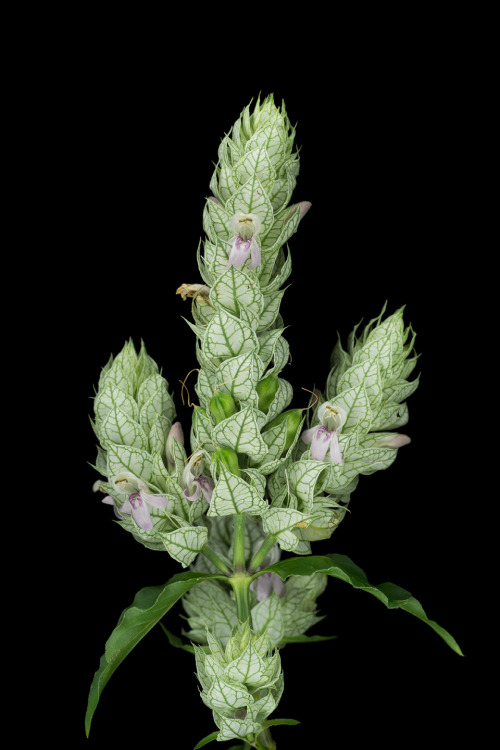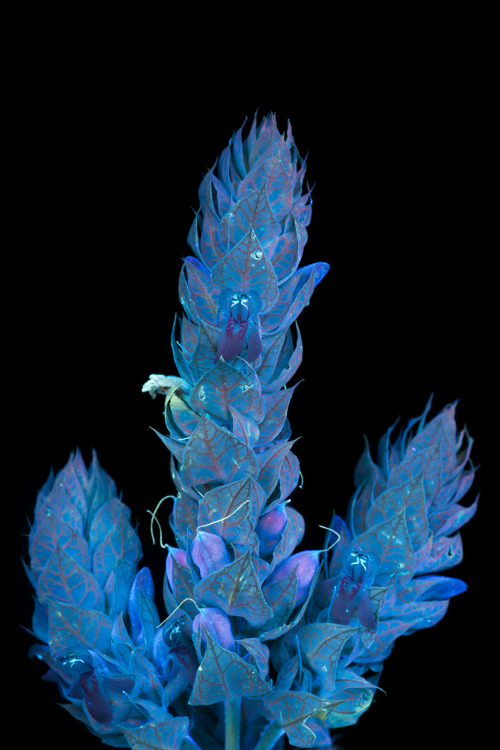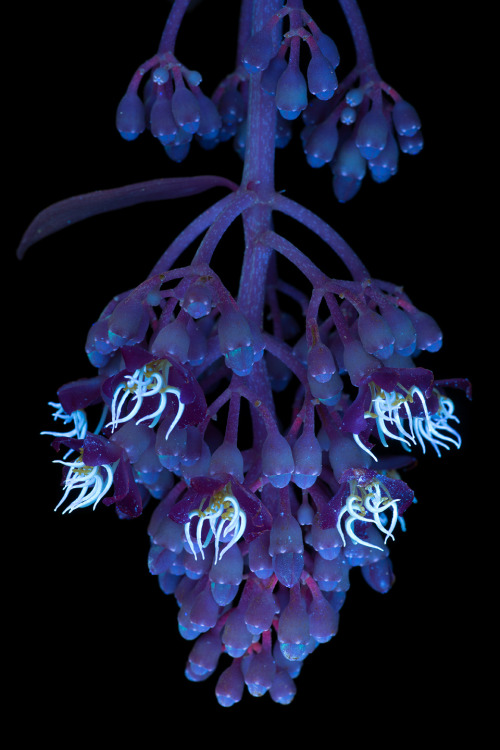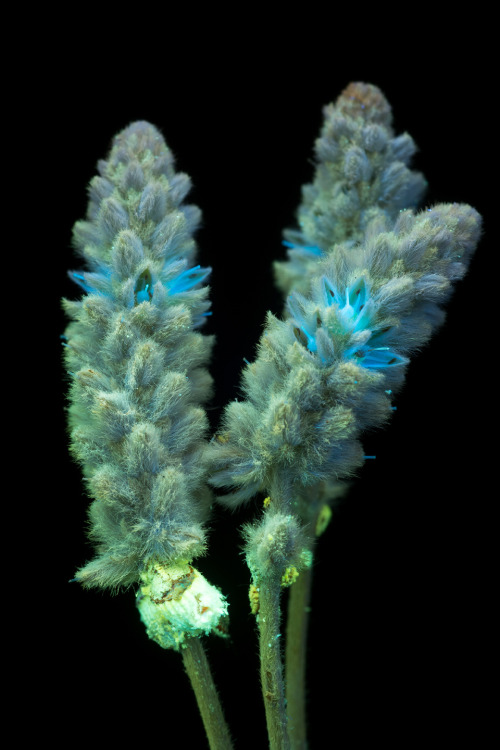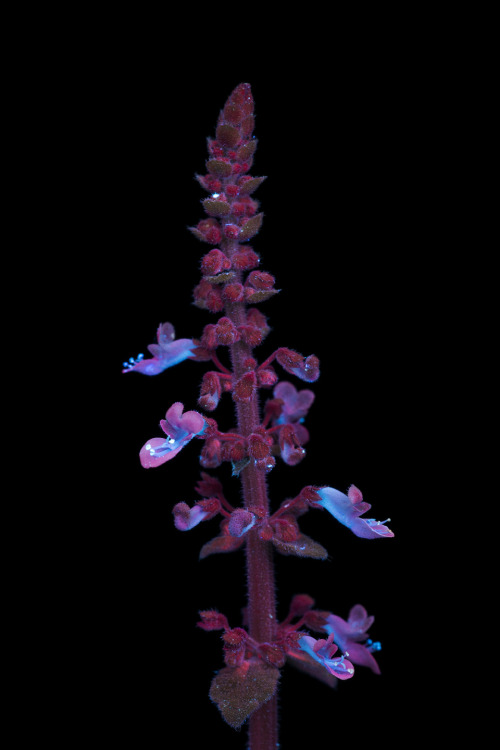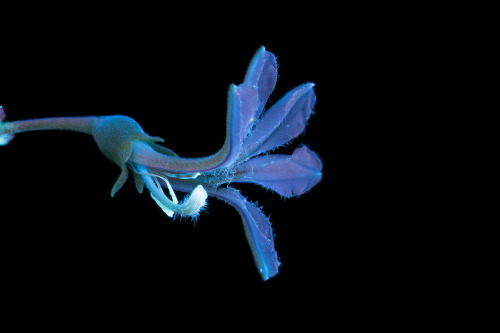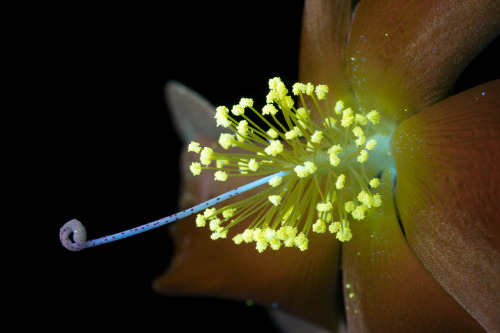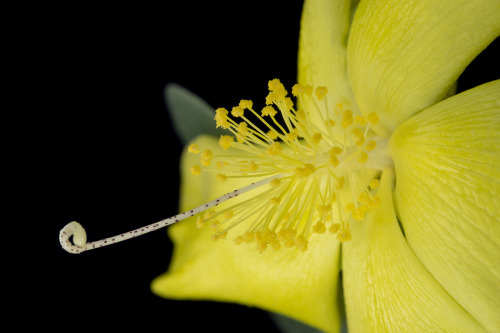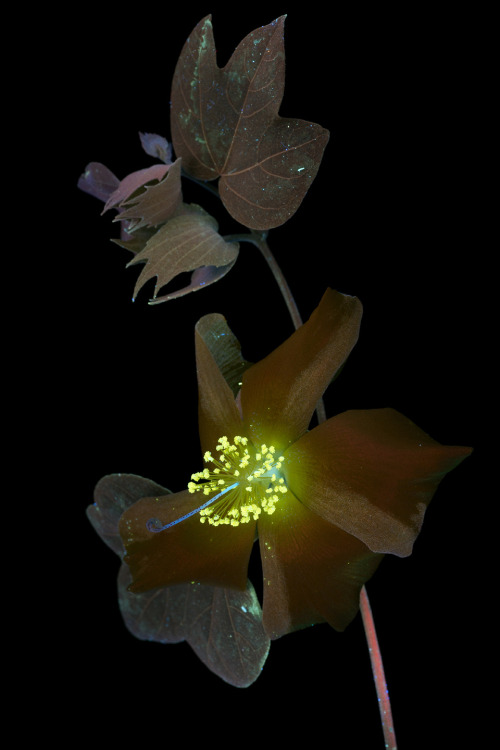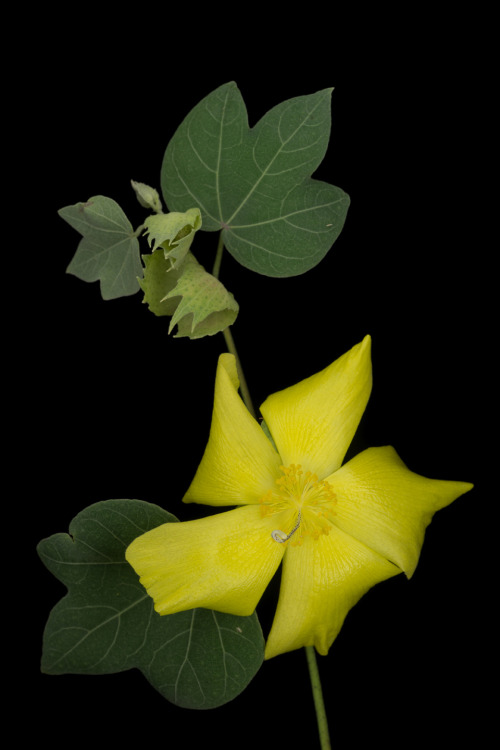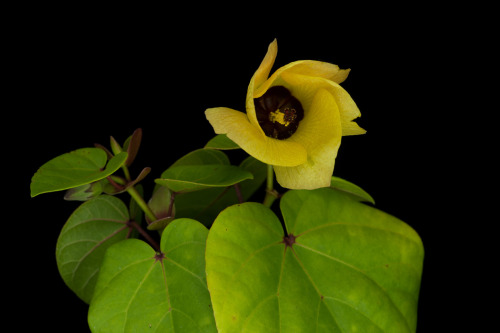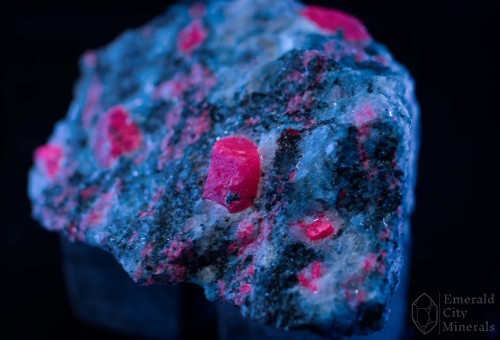#fluorescent
New Shirt design up in my shop at moocyte.com!
Made using my own immunofluorescence microscopy images ♥️

Justicia betonica is the final introduced weed I photographed while on assignment in Hawaii for Hana Hou! This plant, commonly known as Squirrel’s Tail, is native to southwest Asia and eastern Africa but has been introduced throughout the world, particularly in tropical environments such as in South America southeast Asia, Australia, and of course Hawaii. The light-colored bracts are eye-catching, though the actual flower is pale purple to pink and less conspicuous. Altogether the look of it drew my attention long enough to make a collection in the same area as the previously posted AgeratinaandMedinilla. Though listed only as naturalized and not invasive, this plant spreads readily by seed, and given how much of the world in which it can naturally be found, it certainly has potential to become invasive by outcompeting natives and creating monocultures. I still find it a curiously charming plant.
Post link
Medinilla magnifica is a plant native to the Philippines which has spread throughout the tropics and has long been cultivated as an ornamental ‘exotic’ plant. It comes from the family Melastomataceae with which I have little familiarity to the point that from a list of 175 genera I only definitely recognized one (Tibouchina)!
I came across this plant growing in the wild on my first day arriving on Oahu while waiting for my check-in time at the hotel to arrive and collected it and several others in the hopes that at least one would turn out to be a native. It turns out that as with a lot of the flora especially around urban areas, this is an introduced species becoming increasingly naturalized and invasive with time. The two species of Medinilla in Hawaii are problematic because they continue to be sold by oblivious or unscrupulous nurseries and stores, and they produce thousands of tiny seeds which are spread by birds. The plant can grow as a terrestrial or an epiphyte and does well in low light conditions meaning it can displace native plants that would normally grow under the canopy or in some cases right in the crown of rare palm trees.
There’s no doubt that it is a striking plant with great aesthetic value, but after seeing so many native plants at Hui Ku Maoli Ola, Lyon Arboretum, Koko Crater, as well as while hiking, I know there are no shortage of stunning Hawaiian natives and people working hard to get them into the hands of those who are seeking botanical beauty!
Post link
This is the last of my native flora photos from last year’s Hawaii assignment. Fittingly this is from the final shoot and perhaps strangely my favorite of all. This is Nototrichium sandwicense, an endemic species in the Amaranthfamily known in the indigenous language as Kului. The flowers’ white-light color is rather tame, but they remain attractive for the fluffy character and produce a pleasing cyan to green tone when exposed to my ultraviolet light. The leaves may be my absolute favorite thing about this plant though. Especially when grown in bright and dry conditions, the leaves become heavily pubescent, tiny hairs creating a translucent silvery sheen overlaying the green leaf surface. They prefer to grown in dry conditions and are naturally present on many of the islands, growing in various well-drained soils at low to moderate altitudes. If I could choose just one of the plants I photographed to grow at home in California, it would be this species!
For some bonus fun, check out the ant in the final picture. She and her associates were wandering all over the flowers, creating quite a lot of frustration for me. In the end there was one frame where one ant was both somewhat in focus and stationary enough to get a good look at how the body fluoresces under 365nm UV.
This is my last native Hawaiian flower to share. I’ll be taking a short break from posting UVIVF images, but I’ll return with some invasive species I photographed the first night there and probably some infrared images down the line as well!
Thanks to Hana Hou! magazine (in particular Matt Mallams!) for bringing me in on this assignment and both the Lyon Arboretum and Hui Ku Maoli Ola for all the help in providing subjects and sparing the time to talk about things. I hope I’ll have another opportunity in the future to come visit!
Post link
Plectranthus parviflorus, known by Alaala wai nui in Hawaiian, is a plant native to the Hawaiian islands as well as other places throughout the Oceania region. This plant from the mint family is one of the easiest grown natives in Hawaii and once established can actually become somewhat weedy, readily growing in dry conditions, even in sidewalk cracks and the crotches of trees making it semi-epiphytic. The leaves, stem, buds, and ultimately calyx are all fuzzy which together with the ease of growing and willingness to flower make it popular as an ornamental native species.
Post link
Scaevola taccada which goes by quite a few names such as beach cabbage and called naupaka in Hawaii. It shares an order with sunflowers, but is in its own family which is mostly found in Australia barring its genus, Scaevola,which is found in the tropics. It has semi-succulent leaves and grows close to the sea where its fruit is able to float and spread via water (hydrochorous habit). The plant has and has had varied uses throughout time: It has been eaten, used as leis, used to produce dyes, and even used in lieu of saliva to prevent fiving masks from fogging.
While on Oahu, this was one of few native plants I saw outside of the nursery, arboretum, or preserves as it is extensively used in urban landscaping, both commercial and residential. I spied this plant planted along a coastal road as well as right in downtown Honolulu adjacent to a sea of concrete and asphalt.
Post link
Viola chamissoniana is a member of the violet family known as ‘olopu in and endemic to Hawaii where it is found on several of the islands in the chain. The subspecies native to Oahu is a federally-listed endangered species, largely as a result of the grazing of introduced feral goats and pigs which pose a threat to many other Hawaiian endemics. Introduced herbivores are far from the only threat as introduced plants such as Ageratina adenophora pose troublesome competition from a plant I’ve also seen growing wild and introduced here in California. While human development is one of the leading causes of species endangerment and habitat loss, it is clear that secondary effects, even centuries down the line, continue to ravage natural ecosystems.
A less dour fact about Violas is that they usually have two types of flowers borne in different times of year. The flowers we appreciate are known as chasmogamous – showy things designed to attract the attention of would-be pollinators and incidentally us as well. This promotes cross-pollination and in Violaoften results in a seed pod which explodes, propelling diversified seeds to colonize surrounding areas. There are also sneaky flowers which are almost never seen, hunkering close to the base of the plant or even underground. These flowers are cleistogamous and are self-pollinating. The fruit containing these seeds instead dumps them close to the parent plant as the offspring are more likely to have a similar genetic makeup which allows them to thrive in the same conditions.
Thanks to Hui Ku Maoli Ola for lending me this plant as a subject along with the others!
Post link
Gossypium tomentosum, Ma’o, or Hawaiian cotton, is an another endemic member of the mallow family (Malvaceae). It is grown as a small shrub, a groundcover, and is enjoyed for its silky flowers and silvery leaves. Sadly, like many of the other Hawaiian plants I’ve been sharing, it is endangered and has been extirpated from at least one of the Hawaiian islands largely as a result of continued coastal development.
Besides the loss of beauty, variety, and ecological diversity, the extinction of a species always has potential to make lost traits which would have perhaps more conventional value. This cotton illustrates this as even while its population continues to decline, its genes persist in commercial cotton crops after being bred with them to confer enhanced insect and pathogen resistance. While for some the abstract consequences of extinction have no impact, there remain more concrete losses which should leave any person concerned.
Post link
Hibiscus tiliaceus is a widespread member of the mallow family commonly found by beaches as its many sea-inclusive common names suggest. Native through Oceania and South Asia, the plant has now become naturalized throughout he world, including the tropical Americas. There is some dispute about whether it is truly a Hawaiian native plant or whether it was introduced by early settlers who used the plant extensively for its buoyant wood. It also provides fiber from which ropes were made, corky bark which sealed cracks, and parts of the plant can be used to treat fevers and as food. The Hawaiian name for it, hau, appears quite often in contemporary naming for businesses and streets.
H. tiliaceus is one of the very few [sort of] native plants I was able to find and recognize among all the multitudes of introduced species. It was growing alongside a large Thespesia populnea, Ipomea pes-caprae, I. obscura, Abutilon grandifolium, and quite a few clumps of Vitex rotundifolia. It is certainly possible that being close to a coastal rode, the plants were deliberately placed, but even if so, the choice of using natives is to be commended.
The pollen from this species was especially bright, and upon reviewing my photos at full size, I could not only make out the shape of the pollen, but a pronounced contrast of some on the stigma. Where many have the fluorescent coloration and intensity of fresh pollen from the anthers, quite a few are dimmer and blue rather than green. I have two guesses about this. My first thought is that the blue pollen are hollow shells – just the capsule left behind after germination. My second thought is that they are pollen grains from a different species.
If anyone has any insight into which is more likely, I’d love to hear your thoughts as this is something that has been often on my mind for the last 6 months!
Post link
Capparis sandwichiana, the Hawaiian Caper, or maiapilo, is a sprawling, low-growing shrub which inhabits only the Hawaiian islands in coastal and near-coastal ranges. It shares its genus with Capparis spinosa which is commonly used in Mediterranean cooking and shares some traits such as a preference for little water which might be surprising when hearing it is endemic to these tropical islands. The white flowers are fragrant and quite large, serving as nectar source for Manduca blackburni and a forage source for larval Plutella capparidis moths,both of which are also endemic Hawaiian species. The plant is threatened in the wild, which should come as no surprise knowing it’s from the coastal regions and after the information I posted about all the other Hawaiian flora so far.
Curiously, while many plants are given scientific names after people (often European naturalists), others’ names give a description of the plant or its origin. Capparis sandwichiana straddles these two potentials, being named for the location (“The Sandwich Islands”), which were in turn named that by James Cook, a British explorer. I am not the most passionate about plant naming conventions being actually useful, but the surfeit of plants with variations of “sandwich” as epithets is sort of absurd and stupid. While recognizing the value of the taxonomic system to categorize and make distinct species, I think it would be both practical and honorable to integrate native names instead of using monotonous species names such as “sandwichensis” or individuals’ names, for example this plant could be Capparis maiapilo instead. The first flower I posted in this series is actually a good example of it with a taxonomic name of Hibiscus kokio while the Hawaiian name is Kokiʻo.
Anyway, enough of that! I hope you enjoy this plant as much as I did.
Many thanks to Tim K from the Lyon Aboretum for giving me some cuttings from his personal garden in order to document this species.
Post link
Fluorescent vermillion Corundum var ruby (Al2O3) in schist matrix under long frequency UV light. From Mysore corundum deposits, Karnataka, India
Post link
You’ve seen these fluorescent geometric dreams by #OliviaPeake before, but I love them so much I had to share again. This is #Flux. Taking urban architecture to a whole new virtual world. #art #drawing #emergingartist #artist #emergingart #newart #geometric #lines #architecture #space #virtual #virtualworld #newenvironment #constructedspace #colour #fluorescent #neon #dream #love
Post link
Here it is! I’m really glad with this new Prima Watercolor palette :) think I will do a bunch of illustrations with it.
.
The fluorescent red color is beautiful but it’s so hard to take a picture with the right render!
.
#art #artwork #illustration #watercolor #watercolors #drawing #acrylgouache #primawatercolordt #primawatercolors #primawatercolor #fluo #fluorescent #pixie #girl #artist #artistsoninstagram #instapic #instaart #instaartwork #paint #painting #traditionalpainting
https://www.instagram.com/p/BuL_Gp7lgCV/?utm_source=ig_tumblr_share&igshid=1m9jyk9d43kmx
Post link
I’ve always loved fluorescent colors, but on bags, they are exceptionally nice! And if you haven’t noticed, 2 brands in particular seem to be dominating the florescent bag trend. Furla Candy Bag and Cambridge Fluorescent Satchel. Simple design, but HUGE impact! Both are wonderful, but for practicality, as practical as a fluorescent bag can get, I’d choose the Cambridge Satchel.
The Cambridge Fluorescent Satchel…
The Furla Candy Bag…
Here are some looks done with the Cambridge Fluorescent Satchel…
Here are some looks done with the Furla Candy Bag…
Decisions, decisions! Hhhmmmm…?




